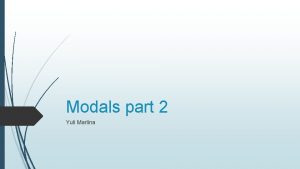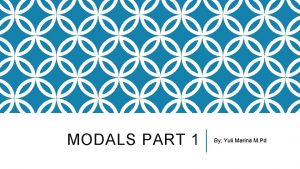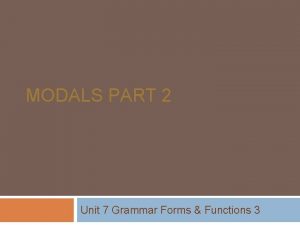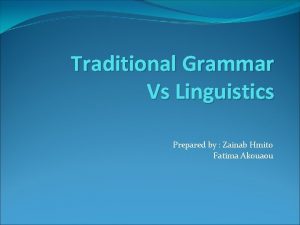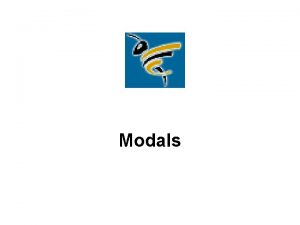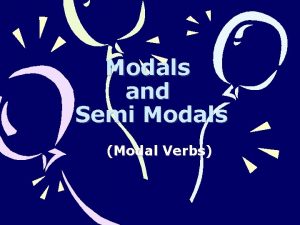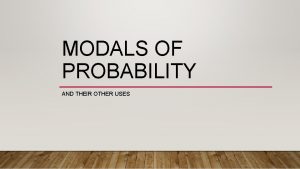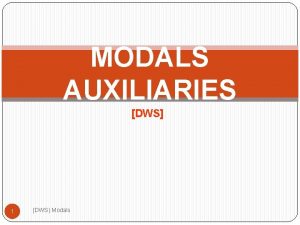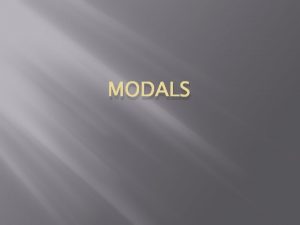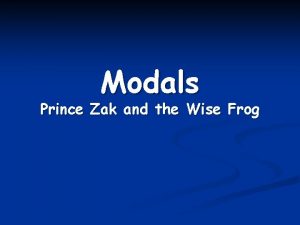Grammar A presentation Chapter 10 Modals Part 2










- Slides: 10

Grammar A presentation: Chapter 10 – Modals, Part 2 Degrees of certainty: MUST AND MAY/ MIGHT/COULD.

9 -1 Basic Modal Introduction – MODAL AUXILARIES GENERALLY EXPRESS SPEAKERS’ ATTITUDES. For example, modals can express that a speaker feels something is necessary, advisable, permissible, or probable, and, in addition, they can convey the strength of those attitudes. Each modals has more than one meaning or use. See Chart 10 -10 p. 204 -205 for a summary over view of modals: – Modal auxiliaries in English – Can could – Shall will had better may would might must ought (to)

Modals, Part 2 - Degrees of certainty must and may/ might/could – Grammar Formulation – All modals verbs have the following features in common – They are always followed by the infinitive without to. The only exception is ought, which is followed by an infinitive (to + the simple form of a verb). – Modal are followed immediately by the simple for of verb, They are the some for all the pronouns. Correct: She can do it. – In correct: she cans do it. – They never combine with another modal verb.

10 -1 Degrees of Certainty: Present Time – Why isn’t John in class? – 100% sure - He is sick Degrees of certainty refers to how sure we are – what we think the chances are – That something is true. – If we are sure something is in the present, we don’t need to use modal. For example, If I say, “John is sick, am sure; I am stating a fact that I am sure is true. My degree is 100% – Why isn’t John in class? – 95% sure -He must be sick ( usually he is in class every day, but when I saw him last night, he wasn’t feeling good. So my best guess is that he is sick today. I can’t think of another possibility.

Degrees of Certainty – Present Time – We use: Must be – Almost 100% sure something is true. – I saw John going into his house – He must be at home. – Nancy is yawning. – She must be sleepy. The speaker is making a logical conclusion.

Degrees of Certainty – May, Might, Could. – Present Time – We use: – 50% May (not) Be sure or less – Might (not) Be Could Be – Not sure something is true. But it is possible. – He speaks French fluently. – He might be from France. – He might be sick – He could be sick ( I don’t really know. He may be at home watching TV. He might be at the library. He could be out of town. May, might and could express a weak degree of certainty. The meanings are all the some. The speaker is saying. “ Perhaps, maybe, possibility John is sick. I am only making a guess. I can think of other possibilities.

Degrees of Certainty: Present Time Negative – This case is contrary of must. – We use: – Couldn’t Be Can’t Be – A) Almost 100% sure something is not true. – I have just seen Jackie at the beach. – 99% sure { She can’t be at work}. – 99%{ Sam couldn’t be hungry}. – B) { Sam can’t be hungry. } That’s impossible. I just saw him eat a huge meal. He has already eaten enough to fill two grown men! Did he really say he’d like something to eat? I don’t believe it. In (b): The speaker believes that there is no possibility that Sam is hungry( but the speaker is not 100% sure). When used in the negative to show degree of certainty, couldn’t and can’t forcefully express the idea that the speaker believes something is impossible.

Past Modals for Degrees of certainty

Degrees of Certainty: Past Time – Past Time: Affirmative – Why wasn’t Mary in class? – A) 100% She was sick. – B) 95% She must have been sick. – C) 50% sure or less {She may have been sick} – { She might have been sick. } – {She could have been Sick} – In (a) The speaker is sure – In (b) The speaker is making a logical conclusion. Means, I saw Merry yesterday and found out that she was sick. I assume that is the reason why she was absent. I can’t think of any other good reason. ” – In ( c ): The speaker is mentioning one possibility.

10 -3 Degrees of Certainty: Past Time: Negative – Why didn’t Sam eat? – (d) 100%: Sam wasn’t hungry – (e) 99% { Sam couldn’t have been hungry. – { Sam can’t have been hungry. – (f) – (g) 50% sure or less {Sam may not have been hungry. – 95% {Sam must not have been hungry. { Sam might not have been hungry. – In (d): The speaker is sure. – In ( e): The speaker believes that it is impossible for Sam to have been hungry. – In ( f ): The speaker is making a logical conclusion. – In ( f): The speaker is mentioning one possibility.


